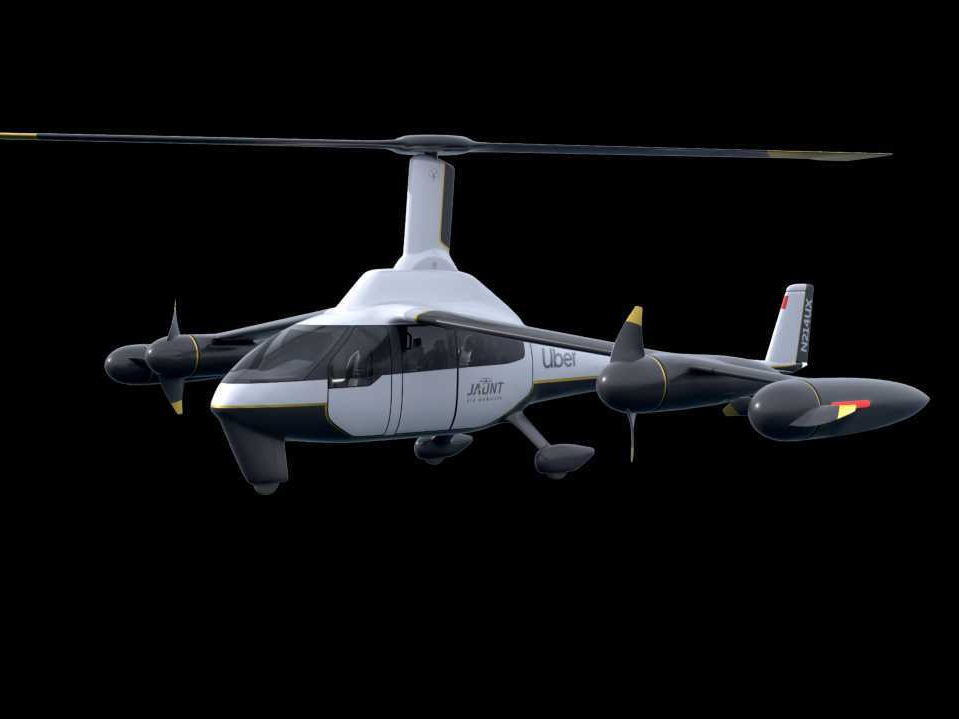- Uber and Jaunt Air Mobility became partners in 2019 with Jaunt tasked with producing an electric take-off and land aircraft or eVTOL for Uber Elevate.
- Jaunt’s design for its Journey eVTOL uses gyrocopter technology with wing-mounted and top rotors to perform vertical take-offs and then propel quickly into forward flight.
- The company expects certification in 2025 with autonomous flight capabilities coming in 2030.
- Visit Business Insider’s homepage for more stories.
Uber first announced at its 2019 Elevate conference that Jaunt Air Mobility was chosen as a partner for the next step in the ride-share company’s urban air mobility endeavor.
Moving forward with Uber’s desire to utilize a fleet of electric take-off and land, or eVTOL, aircraft to soar over congesed roadways, Jaunt is currently developing a gyrocopter-style aircraft with both vertical and horizontal rotors. The Jaunt Journey builds upon VTOL technology that incorporates helicopter-like top rotors and airplane-like propellers.
Unlike tiltrotor aircraft, the Jaunt Journey has three rotors in total, two wing-mounted engines for forward flight and one top rotor for take-off and landings, which is then slowed during flight. The company’s flagship craft can carry four passengers with one pilot and aims to ultimately fly autonomously.
Uber began experimenting in urban air mobility with helicopter operations in major cities primarily connecting downtown heliports with major airports. Notably, Uber Copter operates in New York City connecting heliports in Manhattan with John F. Kennedy International Airport using helicopters operated by HeliFlite.
Just like its ground-based ride-shares, passengers can book the approximately 10-minute helicopter ride via the Uber app complete with transfers if needed. Uber Elevate promises to be no different, according to a video posted on its website, with new rooftop heliports dubbed "Uber Skyports" being built to support the futuristic mode of transport.
Take a closer look at the airborne Ubers of the future.
Uber and Jaunt Air Mobility first announced the partnership at the 2019 Uber Elevate conference in Washington. Jaunt joins industry heavyweights including Bell, Embraer, and Hyundai as one of eight partners.
Source: Jaunt Air Mobility
The idea for the Jaunt Journey is built upon existing gyrocopter and slowed rotor technology. Basically, the top rotor is used to launch the aircraft into the air, at which point the wing-mounted propellers take over.
Source: Jaunt Air Mobility
As the top rotor generates lift more so than the wings, the aircraft can feature smaller wings making for a compact vehicle. Once in the air, the top rotor is slowed by the air and rotates slowly, generating less drag that would slow the craft allowing an increase in the speeds at which it can travel.
Source: Jaunt Air Mobility
The aircraft is being designed to fly at a top speed of 175 miles per hour and fly at up to 18,000 miles per hour. It is limited, however, to a range of 60 miles on a single charge, enough to fly between Washington, D.C. and Baltimore but not from New York to the Hamptons without a recharging stop.
Source: Jaunt Air Mobility
The eVTOLS won't even need to use traditional heliports, according to materials released by the company, with parking lots and building rooftops easily convertible to "Uber Skyports."
Source: Uber
The Journey differs from tiltrotors in that all rotors remain stationary and are simply activated at different points in each flight.
Uber is similarly experimenting with other futuristic VTOLS including the Bell NEXUS, a four-engine tiltrotor.
While larger aircraft like the AW609 have plenty of alternate uses including inter-city travel and long-distance flying, the Journey is ideal for short intra-city air taxi flights thanks to its jump take-off and land capabilities and quick transition to forward flight once airborne.
Source: Jaunt Air Mobility
For quick turnaround times, Jaunt is developing the Journey's battery and charge stations to recharge the aircraft enough for its next flight in as little as seven minutes during peak travel times. Normal charge times are around 15 minutes, the company told Business Insider in an email.
With a planned ceiling of 18,000 feet and IFR-rated capabilities, the Journey will similarly be able to fly in or above adverse weather conditions.
Source: Jaunt Air Mobility
The eVTOL concept is the next step in Uber's aerial ambitions that has already taken shape in the form of helicopter service in New York City with contracted helicopter flights to JFK Airport.
Those flights, however, may soon be operated by the Jaunt Journey with the company planning to receive certification in 2025 and begin autonomous operations in 2030.
Source: Jaunt Air Mobility

